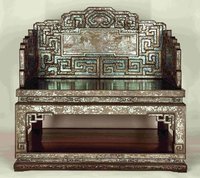Der Bodhisattva Avalokiteshvara ist der Herr des Mitgefühls. Er ist der Schutzpatron Tibets und die Schutzgottheit der tibetischen Gelugpa Schule. Deren Oberhaupt, der Dalai Lama, gilt als Inkarnation von Avalokiteshvara. Von seinen 108 verschiedenen Erscheinungsformen, eine heilige Zahl im tibetischen Buddhismus, wird er am häufigsten mit 11 Köpfen und vielen Armen dargestellt.
Der hier dargestellte Avalokiteshvara, wird stehend mit 8 Armen und 10 Köpfen dargestellt, von denen die unteren neun in ihrer Ausstattung fast identisch sind. Der zehnte Kopf zeigt eine zornvolle Erscheinungsform, um die Gegner des Buddhismus zu besiegen. Als elfter Kopf fungiert der Kopf des Buddha Amitabha, einer der fünf transzendenten Buddhas (jinas) und „spiritueller Vater“ von Avalokiteshvara.
en

